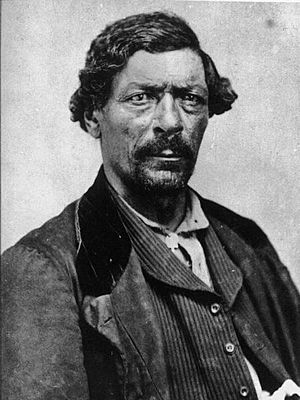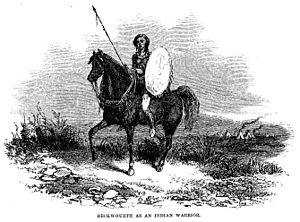James Beckwourth facts for kids
Quick facts for kids
James Beckwourth
|
|
|---|---|

James P. Beckwourth, circa 1856
|
|
| Born |
James Pierson Beckwourth
April 26, 1798 or 1800 Frederick County, Virginia, U.S.
|
| Died | October 28, 1866 or 1867 (aged 67–69) Denver, Colorado Territory, U.S.
|
| Resting place | Crow Indian Settlement, Burial Ground, Laramie, Albany County, Wyoming, U.S. |
| Other names | James Beckwith, Jim Beckwourth |
| Occupation | blacksmith, trapper, wrangler, soldier, rancher, hotel keeper, store keeper, author, scout |
| Employer | slavemaster, Rocky Mountain Fur Company, American Fur Company, Bent, St. Vrain, & Company, U.S. Government, self employed |
| Known for | Being one of the few African-American mountain men, on the American Western Frontier |
| Spouse(s) | An African-American wife and several Native American wives |
| Children | 4 |
| Military career | |
| Allegiance | |
| Service/ |
|
| Rank | U.S. Army wagon master (1837–?), U.S. Army scout (1866) Territorial militia scout (1864) |
| Battles/wars | Second Seminole War (1835–1842)
|
James Pierson Beckwourth (born Beckwith, April 26, 1798 or 1800 – October 29, 1866 or 1867) was an American mountain man, fur trader, and explorer. He was also known as "Bloody Arm" because he was a skilled fighter. James Beckwourth was born into slavery in Virginia. His father, who was white, freed him. James then learned the trade of a blacksmith.
As a young man, Beckwourth moved to the American West. He first connected with fur traders in St. Louis. He lived with the Crow Nation for many years as a fur trapper. He is famous for finding Beckwourth Pass through the Sierra Nevada mountains. This happened during the California Gold Rush years. He also improved the Beckwourth Trail, which thousands of settlers used to travel to central California.
Beckwourth told his life story to Thomas D. Bonner, a traveling judge. The book, The Life and Adventures of James P. Beckwourth, was published in 1856. At first, historians thought the book was just made-up stories. But now, it is seen as an important source of social history, especially about life among the Crow people. The civil rights movement of the 1960s celebrated Beckwourth as an early African-American pioneer. He is now featured as a role model in books for children and in school textbooks.
Contents
Early Life and Freedom
James Beckwourth was born in 1798 in Frederick County, Virginia. He was born into slavery. His mother was an African American woman who was enslaved. His father was their white master, Sir Jennings Beckwith. James was said to be the third of his mother's thirteen children.
Around 1809, when James was young, his father moved to Missouri. He took James's mother and all their children with him. James's father treated his mixed-race children as his own. However, he still legally owned them as enslaved people. His father arranged for James to become an apprentice to a blacksmith. This way, James could learn a useful trade.
At age 19, James was fired by the blacksmith after an argument. His father then freed Beckwourth. This was done legally in court between 1824 and 1826.
Adventures in the West
Becoming a Mountain Man
In 1824, James Beckwourth joined General William Ashley's Rocky Mountain Fur Company. He worked as a wrangler, helping to manage horses during an expedition to explore the Rocky Mountains. In the years that followed, Beckwourth became a well-known trapper and mountain man.
In July 1825, at a gathering of trappers called a rendezvous, a colleague named Caleb Greenwood told a story. He claimed Beckwourth was the child of a Crow chief. He said Beckwourth had been stolen as a baby by raiding Cheyenne and sold to white people. Many people believed this story. Beckwourth had started dressing like Native Americans, and some people thought he was an Indian.
Later that year, Beckwourth said he was captured by the Crow people. This happened while he was trapping furs in an area between the Crow, Cheyenne, and Blackfoot lands. He claimed they thought he was the lost son of a Crow chief. So, they welcomed him into their nation. Other stories suggest that his time with the Crow was planned by the fur company. This was to help them trade more with the tribe. Beckwourth married the daughter of a Crow chief. It was common for fur trappers and traders to marry Native American women. These marriages created valuable partnerships for both sides.
For the next eight or nine years, Beckwourth lived with a Crow band. He became a respected warrior and then a chief. He was a leader of the "Dog Clan." In his book, he said he became the highest-ranking war chief of the Crow Nation. He continued to trap furs. However, he sold them to the American Fur Company, a rival of his old partners. Beckwourth joined the Crow in raids against neighboring tribes. Sometimes these raids turned into battles, often against their traditional enemies, the Blackfoot.
In 1837, the American Fur Company did not renew his work contract. Beckwourth then went back to St. Louis. He volunteered to help the United States Army in the Second Seminole War in Florida. In his book, he said he was a soldier and messenger. But historical records show he was a civilian wagon master, helping with supplies.
From 1838 to 1840, Beckwourth traded with the Cheyenne people. He worked near the Arkansas River out of Fort Vasquez, Colorado. In 1840, he started working for Bent, St. Vrain & Company. Later that year, Beckwourth became an independent trader. He and other partners built a trading post in Colorado. This post became the center of the community of Pueblo, Colorado.
In 1844, Beckwourth traded on the Old Spanish Trail. This trail went between the Arkansas River and California, which was then controlled by Mexico. When the Mexican–American War started in 1846, Beckwourth returned to the United States. He brought almost 1,800 stolen Mexican horses with him. During the war, he worked as a courier for the U.S. Army. He also helped stop the Taos Revolt. His former boss, Charles Bent, who was then governor of New Mexico, was killed in that revolt.
Finding the Beckwourth Pass
By 1848, the California Gold Rush had begun, and Beckwourth went to California. He first opened a store in Sonoma. He soon sold it and moved to Sacramento. Sacramento was a fast-growing town near the gold mines. There, he worked as a professional card player.
In 1850, Beckwourth is credited with discovering what became known as Beckwourth Pass. This was a low-elevation pass through the Sierra Nevada mountains. In 1851, he improved what became the Beckwourth Trail. This trail was originally a Native American path through the mountains. It started near Pyramid Lake and the Truckee Meadows east of the mountains. It then climbed to the pass named for him. After that, it went along a ridge between two parts of the Feather River. Finally, it passed through the gold fields of northern California and on to Marysville.
The Beckwourth Trail saved settlers and gold seekers about 150 miles (240 km). It also helped them avoid several steep hills and dangerous passes, like Donner Pass. Beckwourth said that the businesses in the California gold towns were supposed to pay for the trail's creation. However, when he tried to collect his payment in 1851, Marysville had suffered two big fires. The town leaders could not pay him. In 1996, the City of Marysville renamed its largest park as Beckwourth Riverfront Park. This was to honor his help in developing the city and to recognize the old debt.
Beckwourth started ranching in the Sierra Nevada. His ranch, trading post, and hotel, in today's Sierra Valley, became the start of the settlement of Beckwourth, California. In the winter of 1854-1855, the traveling judge Thomas D. Bonner stayed at Beckwourth's hotel. During the winter nights, Beckwourth told Bonner his life story. Bonner wrote it down and published the book in 1856. Beckwourth was supposed to get half of the money from the book, but he never received any.
Working for the Government
In 1859, Beckwourth briefly returned to Missouri. Later that year, he settled in Denver, Colorado Territory. He worked as a storekeeper for Louis Vasquez again. He was also appointed as a local Indian agent, working with Native American tribes.
In 1864, Colonel John M. Chivington hired Beckwourth as a scout. Chivington was the commander of the 3rd Colorado Cavalry Regiment. Beckwourth was to help in a campaign against the Cheyenne and Apache tribes. This group was a volunteer militia formed to fight Native American groups in the territory for American settlers. This campaign led to the Sand Creek massacre. In this event, the militia killed an estimated 70 to 163 peaceful Cheyenne men, women, and children. These Cheyenne had camped in an area suggested as safe by a previous commander of Fort Lyon. They were flying an American flag to show they were peaceful. Because of his connection to the massacre, the Cheyenne would no longer trade with Beckwourth.
Even in his 60s, Beckwourth returned to trapping. In 1866, during Red Cloud's War, the U.S. Army hired him as a scout. He worked at Fort Laramie and Fort Phil Kearny.
Death
While guiding a military group to a Crow band in Montana, Beckwourth felt very sick. He had severe headaches and nosebleeds. He returned to the Crow village, where he died in 1867. William Byers, a friend and the founder of the Rocky Mountain News, claimed the Crow had poisoned Beckwourth. He said the tribe no longer trusted him because of his involvement in the Sand Creek massacre. However, Byers had no proof, and this was just his guess. Beckwourth's body was placed on a raised platform. This was a traditional burial custom of the Crow Tribe. His burial ground is near Laramie, Albany County, Wyoming.
Legacy
- Beckwourth Pass, named in honor of Beckwourth, is in the Sierra Nevada Mountains in Plumas County, California. The Western Pacific Railroad used this pass and route to cross the Sierra. The pass is east of Portola, California. State Route 70 crosses the Sierra at this pass. It is one of the lowest crossings of the Sierra Nevada in California, at an elevation of 5,221 feet (1,591 m).
- In 1994, the U.S. Postal Service released a stamp honoring Beckwourth. It was part of the Legends of the West series.
- In 1996, the city of Marysville, California, renamed its largest park as Beckwourth Riverfront Park. This was to remember his help in developing the city. For a few years, "Beckwourth Frontier Days" were celebrated every October. This was the only living history festival in northern California.
- What is now West 5th Ave. in Denver, Colorado, was named Beckwourth Street (sometimes Beckwith) after James Beckwourth.
- In 2011, a memorial was put up in Pueblo, Colorado. It honored Beckwourth's role in founding that city.
See also
 In Spanish: James Beckwourth para niños
In Spanish: James Beckwourth para niños


